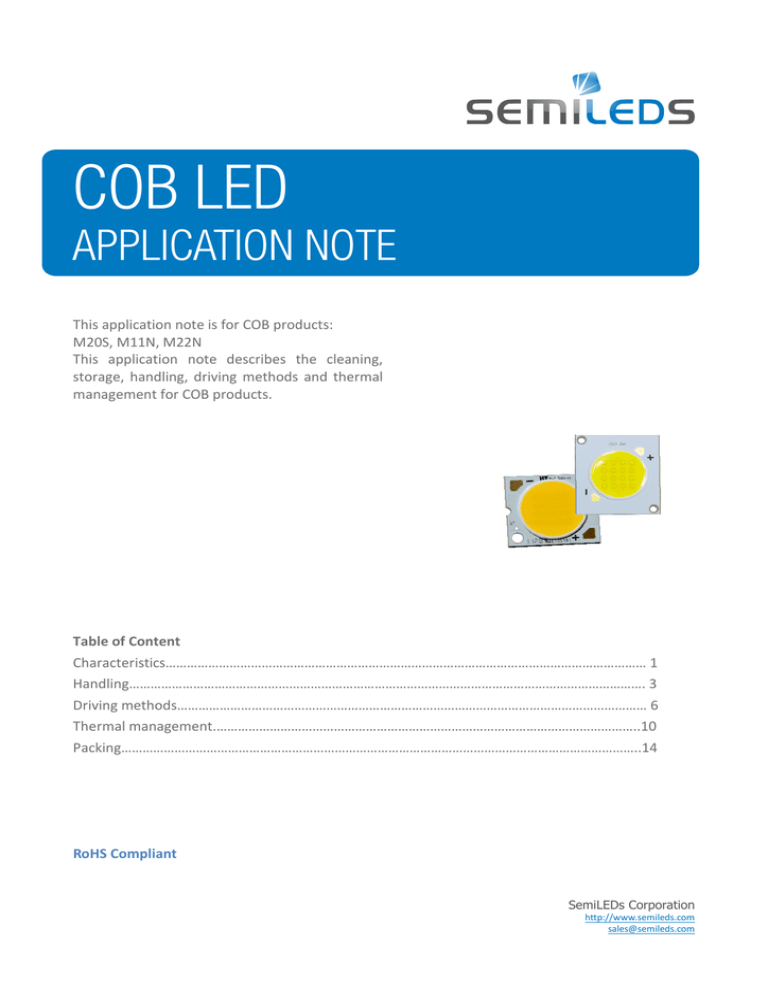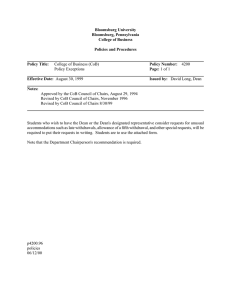
COB LED
APPLICATION NOTE
This application note is for COB products:
M20S, M11N, M22N
This application note describes the cleaning,
storage, handling, driving methods and thermal
management for COB products.
Table of Content
Characteristics……………………………………………………………………………………………………………………… 1
Handling………………………………………………………………………………………………………………………………. 3
Driving methods…………………………………………………………………………………………………………………… 6
Thermal management.………………………………………………………………………………………………………..10
Packing………………………………………………………………………………………………………………………………..14
Handling............................................................................................................................3
Driving methods..........................................................................................................…. 6
Thermal management .................................................................................................... 10
Packing ............................................................................................................................ 1
RoHS Compliant
SemiLEDs Corporation
http://www.semileds.com
sales@semileds.com
COB Application Note
Cleaning and Storage
Cleaning
Products were cleaned thoroughly before shipping, which means that in most normal cases there is no
need to clean before using. In cases where it cannot be guaranteed that only a minimal amount of dirt and
dust particles will come in contact with the product, it is advised to follow the following suggestions.
1. During handling, keeps the environment cleaning.
2. Try swabbing gently using a lint-free swab.
3. If needed, the use of lint-free swab and IPA(isopropyl alcohol) or Alcohol used gently removes
dirt from the surface. Do not use other solvents as they may directly react with the LED emitting
region.
4. Do not use ultrasonic cleaning that the LED will be damaged.
5. Do not press on the emitting region.
Recommended Conformal Coatings
SemiLEDs has found that the following conformal coatings are safe to use with COB products. Conformal
coating should not be applied directly to or over the LED emitting area as it may hinder the LED’s optical
performance and reliability.
• Humiseal 1H20AR1/S
• Humiseal UV40
• Humiseal 1B73
• Humiseal 1C49LV
• Dow Corning 1-4105
• Dow Corning 1-2577
• Dow Corning 3-1953
• Dymax 9-20557
• Shat-R-Shield
• TechSpray Turbo-Coat Acrylic Conformal Coating (2108-P)
Harmful chemicals
SemiLEDs has found the following chemicals to be harmful to COB in testing. The fumes from even small
amounts of these chemicals may damage the LEDs.
• Toluene, benzene, xylene
• Methyl acetate or ethyl acetate
RoHS Compliant
COB Application Note V1.1
Subject to change without notice
©2005-2012 SemiLEDs. All Right Reserved
www.semileds.com
Page
1
COB Application Note
• Cyanoacrylates
• Glycol ethers
• Formaldehyde or butadiene
• Dymax 984-LVUF conformal coating
• Loctite Sumo Glue
• Gorilla Glue
• Clorox Clean-Up Cleaner spray
• Clorox bleach
• Loctite 384 adhesive
• Loctite 242 threadlocker
• Loctite 7387 activator
Storage
SemiLEDs recommend storage conditions
Before opened:
• Temperature 5 ~ 30 ℃, Relative humidity less than 60 %, LED should be used within a year.
After opened:
• Temperature 5 ~ 30 ℃, Relative humidity less than 60 %.,
• Please apply soldering within 1 week
• LED should be kept in an aluminum moisture proof bag with a moisture absorbent material
• Avoid exposing to air with corrosive gas If exposed, electrode surface would be damaged, which may
affect soldering.
RoHS Compliant
COB Application Note V1.1
Subject to change without notice
©2005-2012 SemiLEDs. All Right Reserved
www.semileds.com
Page
2
COB Application Note
Handling
Recommended Handling
If it is necessary to manually pick and place the product, it is recommended to use plastic tweezers or
plastic gloves. Do not touch the lens with tweezers or fingers. Gently grab the base of the COB using
tweezers.
o
o
x
x
Figure 1. Proper use of tweezers
RoHS Compliant
COB Application Note V1.1
Subject to change without notice
©2005-2012 SemiLEDs. All Right Reserved
www.semileds.com
Page
3
COB Application Note
If metal tweezers need be used, do not choose the one list as Figure 2.
●Tweezers
o
x
△
Figure 2. Recommended tweezers selection
Incorrect handling during assembly
x
x
Press on the emitting region
Touch the both electrode
Pick up on the emitting region
x
Figure 3.Incorrect handling during assembly
RoHS Compliant
COB Application Note V1.1
Subject to change without notice
©2005-2012 SemiLEDs. All Right Reserved
www.semileds.com
Page
4
COB Application Note
Soldering
Soldering pads are suitable for electrical wiring. SemiLEDs recommends that the manual soldering condition
are 350°C±5°C, <5sec.
Anti-static protection
LED devices are static sensitive which means that it is essential to lower the exit static and keep the LED
operation environment static free.
a.
b.
c.
d.
e.
f.
Be sure to wear hand or finger gloves.
Wear wrist straps and make sure that they are grounded.
Use an anti-static floor and make earth.
Avoid wiping hands or putting on/removing clothes in the manufacturing area.
Use anti-static bag when packing.
Material such as plastic or rubber contain carbon or conductive polyester are recommended.
RoHS Compliant
COB Application Note V1.1
Subject to change without notice
©2005-2012 SemiLEDs. All Right Reserved
www.semileds.com
Page
5
COB Application Note
Driving methods
It is necessary to understand the characteristics of LEDs and choose the most suitable system for stable
light emission.
1. Understanding the characteristics of LED
a. It is important to remember that an LED is a type of semiconductor so is made up of various elements.
b. Fluctuations in If have a significant influence on light emission and heat generation of LEDs.
The forward current “If” varies widely with fluctuation in the forward voltage “Vf”. In Figure 4, a 10%
rise in Vf results in an increase almost 3 times under constant temperature conditions.
Figure 4.
c. Figure 5 shows that LEDs require a minimum voltage, which is call threshold voltage or turn on voltage,
to be applied across the junction before current flows, generate light.
Figure 5.
d. Product performance is decided by the I-V curve. Figure 6 shows current distribution is defined by
minimum and maximum values. The fluctuations in If have a significant influence on light emission and
heat generation of LEDs. Especially, strict control of If is required for high-power LEDs because they are
driven by large current.
RoHS Compliant
COB Application Note V1.1
Subject to change without notice
©2005-2012 SemiLEDs. All Right Reserved
www.semileds.com
Page
6
COB Application Note
Figure 6.
2. Constant voltage drive system
Constant voltage drive system means to supply a certain voltage to an LED. But the temperature coefficient
℃
of Vf (mV/ ) is minus, which means that the Vf will decrease as the temperature increases. For example,
In the case of Figure 7, when the case temperature Tc is 90°C, the same amount of current is achieved by
approximately 7% lower Vf than that of the condition in which Tc is 25°C.
Therefore, a constant voltage drive system would be an unstable drive system for LEDs. Temperature
changes lead to changes in Vf and current. Accordingly, the brightness of an LED can be unstable as it
depends on current. Thus, when driving with a constant voltage is employed; an appropriate measure such
as the connection of current control resistance needs to be implemented based on an assumption of the
temperature in actual use.
Figure 7.
3. Constant current drive system ( recommended )
The system that continues to supply a certain current is named a constant current drive system. Different
environmental conditions or other parameters will not change brightness of LED in this stable system.
SemiLEDs recommends the constant current drive system to ensure stable light emitting output and
reliability.
RoHS Compliant
COB Application Note V1.1
Subject to change without notice
©2005-2012 SemiLEDs. All Right Reserved
www.semileds.com
Page
7
COB Application Note
4. Precautions for inrush current
If using a constant current limited voltage driver to light up the LED module, please connect the power
supply and the LED module before plugging the power supply into the AC power cord. This can reduce the
probability of surge current damaging the LED modules.
5. Connection between multiple LEDs array
Most luminaires are designed in a way that combines multiple LEDs array. There is a need for them to light
up at the same time. Some recommendations are provided below:
Figure 8 shows that multi-LED arrays are connected in series when using single output constant channel.
Figure 8.
Figure 9 shows that multi-LED arrays are driven with two or more output constant current channel
Figure 9.
RoHS Compliant
COB Application Note V1.1
Subject to change without notice
©2005-2012 SemiLEDs. All Right Reserved
www.semileds.com
Page
8
COB Application Note
Two different designs above can be combined as figure 10, and it could be realized with one constant
current source.
Figure 10.
Parallel design is not allowed
It’s not recommended to connect COB in a parallel circuit as figure 11 because of variations in the forward
voltage of the individual COB. This may have an influence in flux and color and may affect the reliability of
the lighting system.
x
Figure 11
RoHS Compliant
COB Application Note V1.1
Subject to change without notice
©2005-2012 SemiLEDs. All Right Reserved
www.semileds.com
Page
9
COB Application Note
Thermal management
Introduction
COBs that range from 7W~100W are the most popular to Bulb and general lighting, whereas most of power
dissipation transfer to heat. The more input power is required for LED and the more heat is generated
dramatically. If heat gathers inside the LED, it will cause degradation of luminous efficiency and life, and
result in difficulty in obtaining expected performance. It’s essential to have a good thermal design to
release it. Here is the explanation of resistance necessary for heat design and how to measure the Tc.
Thermal resistance
It shows a cross-section and a simple thermal model for a COB mounted to a heat sink in Figure 11. A
simple thermal model or thermal circuit can illustrate the heat flowing through a COB. Heat release path
from location of heat generation for LED chip to ambient is as below:
LED chip Die-attach resin MCPCB thermal interface heat sink Ambient
Figure 11
Where:
Tj is the temperature at the junction of the device
Tc is the temperature at the case of the COB
Th is the temperature at the point where the heat sink is attached to the COB
Ta is the ambient air temperature
Rjc is the thermal resistance from junction to case of the COB
Rch is the thermal resistance between the case of the COB and the heat sink
Rha is thermal resistance between heat sink and ambient
RoHS Compliant
COB Application Note V1.1
Subject to change without notice
©2005-2012 SemiLEDs. All Right Reserved
www.semileds.com
Page
10
COB Application Note
Unit of thermal resistance is
increase.
℃/W, which means the relationship between input voltage and temperature
℃
℃ per every input power 1W.
For example, 20 /W means that temperature goes up 20
Following equation 1 with thermal resistance represents the relationship between Tj and Ta.
Tj = Ta + Rha × Pd + Rch × Pd + Rjc × Pd
= Th + Rch × Pd + Rjc × Pd
= Tc + Rjc × Pd
Equation 1
A thermal circuit is also similar to an electric circuit. So we could think of thermal resistance as resistance in
electric circuit
Equation 2 depicts the method for adding series thermal resistance values.
Rja = Rjc + Rch + Rha= Rjh + Rha
Equation 2
Where Rja is typically referred to as the system thermal resistance
Furthermore, when assembling multiple COBs on a single heat sink, the rule of parallels applies.
This is depicted in Equation 3.
1/ Rjh = 1/ R1jh + 1/ R2jh + … + 1/ Rn jh
Equation 3:
In Equation 3, “n” refers to the number of COB mounted onto a single heat sink and Rnjh is the thermal
resistance from the LED junction to the heat sink of each of the individual COB. It should be noted that
when using this model the total power (sum of all COBs mounted to the single heat sink) must be multiplied
by the system thermal resistance to calculate the case or junction temperature.
Multi COBs mount onto a single heat sink, and thermal mode or thermal circuit is illustrated as Figure 12.
According to equation 1 &2, the complex mode can be simplified as Figure 13.
RoHS Compliant
COB Application Note V1.1
Subject to change without notice
©2005-2012 SemiLEDs. All Right Reserved
www.semileds.com
Page
11
COB Application Note
Figure 12: multiple COBs on a single heat sink
Figure 13: simplify the multiple COBs on a single heat sink
Thermal design-External heat dissipation mechanism
The thermal resistance Rca, which is the combination of the heat dissipation grease and the heat sink, is
limited by the input power Pd, the ambient temperature Ta, and the thermal resistance of the package Rjc.
Equation 1 could be simplified as equation 4.
Tj = Ta + Rha × Pd + Rch × Pd + Rjc × Pd
= Ta+(Rjc+Rch+Rha) ×Pd
= Ta+(Rjc+Rca) ×Pd
Equation 4
RoHS Compliant
COB Application Note V1.1
Subject to change without notice
©2005-2012 SemiLEDs. All Right Reserved
www.semileds.com
Page
12
COB Application Note
Rca equation converted from equation 4 is showed in equation 5. It is a straight line with the slope of -1 /
Pd and the intercept of Tj / Pd - Rjc. The higher the ambient temperature Ta and the larger Pd, the smaller
the allowable thermal resistance outside the package
Rca=-Ta/Pd+ Tj/Pd- Rjc
Equation 5
In brief, the grease and the heat sink, with smaller thermal resistance ( this means better heat dissipation ) ,
are required in order to keep Tj from exceeding 120°C, the absolute maximum rating in the specifications.
This is the case if the ambient temperature becomes higher and/or the driving current is larger.
Tc measure point
Tc in this application note is measured by thermo coupler attached to the point mentioned in Figure 14.
Soldering is recommended to attach thermometer to this point.
When driving M20 mounted onto the heat sink, it’s better to control the Tc temperature below 70°C. The
Rjc of M20 in the datasheet is 0.65 °C/W.
Tj is calculated as below if Tc is 70°C.
Tj=Tc + Rjc x Pd=70 + 0.65 x16=80.4°C. It’s safe for inside general lighting.
Figure 14
RoHS Compliant
COB Application Note V1.1
Subject to change without notice
©2005-2012 SemiLEDs. All Right Reserved
www.semileds.com
Page
13
COB Application Note
Packing
M20
One tray composed of 12 pieces
Dimension of tray is as below:
M11 & M22
One tray composed of 15 pieces
Dimension of tray is as below:
RoHS Compliant
COB Application Note V1.1
Subject to change without notice
©2005-2012 SemiLEDs. All Right Reserved
www.semileds.com
Page
14
COB Application Note
Notice:
This product is not for use, sale, or importation into the United States. Any agreement, documentation, or
communication (in any form, through any medium and for any purpose) related to this product is provided
subject to the above disclaimer, and no (and seller hereby disclaims any) indemnification is provided for this
product against any infringement claim of intellectual property rights in the United States. The limitations
above do not apply to products that are purchased and delivered before October 1, 2012.
RoHS Compliant
COB Application Note V1.1
Subject to change without notice
©2005-2012 SemiLEDs. All Right Reserved
www.semileds.com
Page
15
COB Application Note
About Us
SemiLEDs Corporation is a US based manufacturer of ultra-high brightness LED chips with
state of the art fabrication facilities in Hsinchu Science Park, Taiwan. SemiLEDs specializes in the
development and manufacturing of vertical LED chips in blue (white), green, and UV using a
patented copper alloy base. This unique design allows for higher performance and longer lumen
maintenance. In December 2008, The World Economic Forum recognized SemiLEDs innovations
with the 2009 Technology Pioneer Award. SemiLEDs is fully ISO 9001:2008 Certified
SemiLEDs is a publicly traded company on NASDAQ Global Select Market (stock symbol “LEDS”).
For investor information, please contact us at investors@semileds.com.
For further company or product information, please visit us at www.semileds.com or please
contact sales@ semileds.com.
www.semileds.com
ASIA PACIFIC
3F, No. 11, KeJung Rd.
Chu-Nan Site
Hsinchu Science Park
Chu-Nan 350, Miao-Li County
Taiwan, ROC
Tel: +886-37-586788
Fax: +886-37-582688
sales@semileds.com
RoHS Compliant
COB Application Note V1.1
Subject to change without notice
©2005-2012 SemiLEDs. All Right Reserved
www.semileds.com
Page
16


